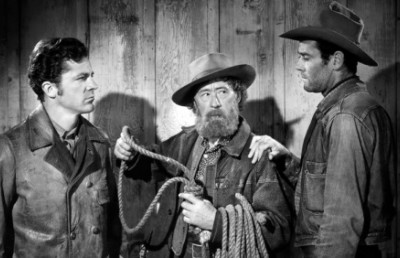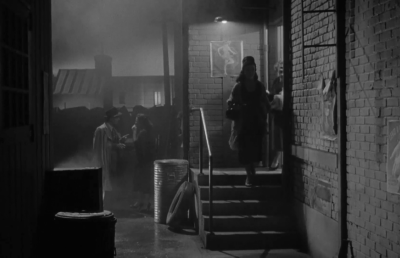Subverting gender – Cornell Woolrich and the women of film noir
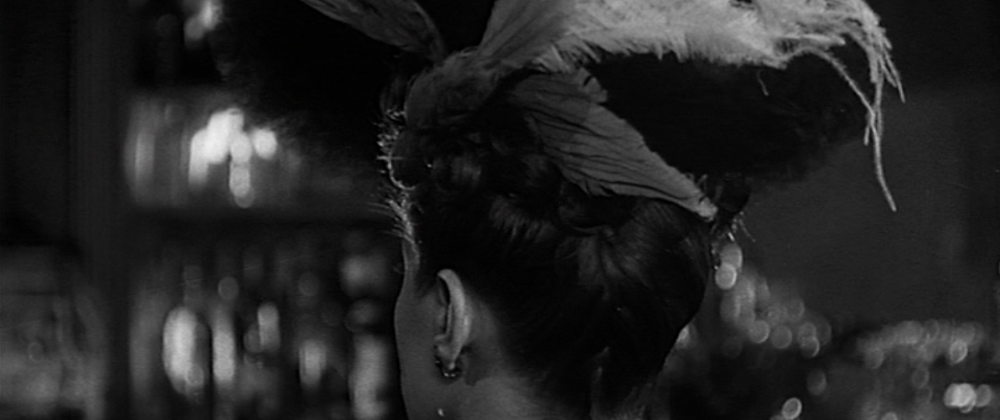
“One of the depressing aspects of the study of women in art works is the repetition of the same structures, showing the stronghold of patriarchy” (Kaplan 1).
These are E. Ann Kaplan’s opening words of her 1980 edition of her book on the place of women in film noir. Because they are right and true, these words become almost as depressing as the observation itself, which of course applies to the representation of women in film noir. From Kathie Moffat to Cora Smith, Phyllis Dietrichson to Kitty Collins, femme fatales have populated the universe of film noir, giving somewhat bad press to the fairer sex, as they were often conveyed as ruthless seductresses or merciless murderesses. Furthermore, in most cases, the women of film noir were introduced in blatantly scoptophilic shots, which made clear that they were indeed objectified by the male gaze. Patriarchal in essence, the quintessential films noir makes it clear that a woman should, contrarily to the femme fatale, be virtuous and respect their gender dictated role.
However, some films that are considered ‘noir’ display a clear will to revaluate and change the mold of female representation in moving pictures. For instance, many of the films inspired by the literary work of Cornell Woolrich can be taken as examples here, as they seem to bring more nuance to the role of women in film noir. Indeed, as Woolrich tries to revise and subvert the gender roles in his novels, his efforts are sometimes translated on the Silver screen in films that bear his name in their credits. Noir pictures such as Black Angel (Roy William Neill, 1946), Phantom Lady (Robert Siodmak, 1944) and The Bride Wore Black (François Truffaut, 1968) can be cited as examples of the ways in which Cornell Woolrich has attempted to change the patriarchal structure that encompass the representation of women in art. A discussion of the female protagonist of the three aforementioned films therefore prompts a further exploration of the presentation of gender roles and of the male gaze.
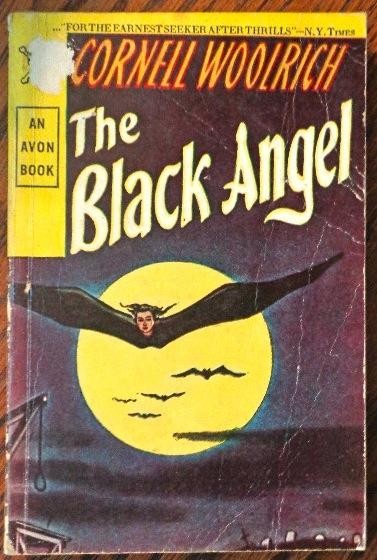
Published in 1943, The Black Angel was Cornell Woolrich’s ninth novel. It tells the story of Alberta Murray, whose husband is wrongly accused of his mistress’ murder. In an effort to save her husband from the gallows, Alberta tracks down and destroys four other men who could have committed this murder. One of her suspects falls in love with her, but confesses to the murder when she tells him that she will stay faithful to her husband despite his infidelity. In the book, Alberta becomes quite obsessed with her quest, which makes her a true ‘black angel,’ preoccupied with nothing else but to find justice for her husband.
Three years later, the novel was adapted to the big screen by Sherlock Holmes’ director Roy William Neill, who, along with screenwriter Roy Chanslor, made major changes to Woolrich’s source material. Perhaps because the idea of a vindictive female heroine seemed to shocking for the film-going audiences of the late 1940s, Neill and Chanslor started out by making the female lead significantly more sympathetic, both to the male suspects – two in the film instead of four – and to the general public. Here, Alberta Murray takes the name of Catherine Bennett and acquires the traits of a frightened yet loving wife who is engaged in a combat against time to save her husband. However, contrary to her lone-warrior persona from the novel, the heroine of the film does not accomplish her mission alone, but rather with the help of the murder victim’s ex-husband, Marty Blair. Although not as solitaire in her mission as she is in the novel, Catherine Bennett’s quest to save her husband allows her to be defined as a seeker-hero, in the words of writer Michael Walker. Walker defines a seeker-hero film noir as an investigative structure oriented film, in which “the hero’s investigation takes the form of a quest into a dangerous and threatening world, the noir world” (Walker 10). Indeed, in her quest to free her husband, Catherine will discover a rather glum world in Mr. Marko’s club, where she will have to be ready for everything to carry out her mission. Furthermore, in most seeker-hero film noir, such as Murder My Sweet, The Killers or Out of the Past, the seeker protagonist is a male and the female characters can be interpreted as femme fatales, which reinforces the patriarchal structure in which women are represented. By making his seeker-hero a woman in Black Angel, Cornell Woolrich shows a will to overturn the classical trope of female representation.
At the end of the novel, Alberta is reunited with her rescued husband, but realises that her experience has made her a different woman, who does not crave the security afforded by her husband as she did before. Although she chooses to stay loyal to her unfaithful husband, she has become more liberated and less inclined to be simply a wife. The end of the novel expresses a certain positive change in the role of the woman as represented in literary works. The final scenes of Neill’s adaptation are somewhat more problematic, as Catherine goes back to her husband, happy to resume her wifely duties. Even before she learns that Marty Blair is the true killer, she turns him down when he confesses his love for her, stating that she has only ever loved her husband. The film’s end then becomes more conservative as it depicts a perfect portrait of a wife who knows her place and her role in the home.
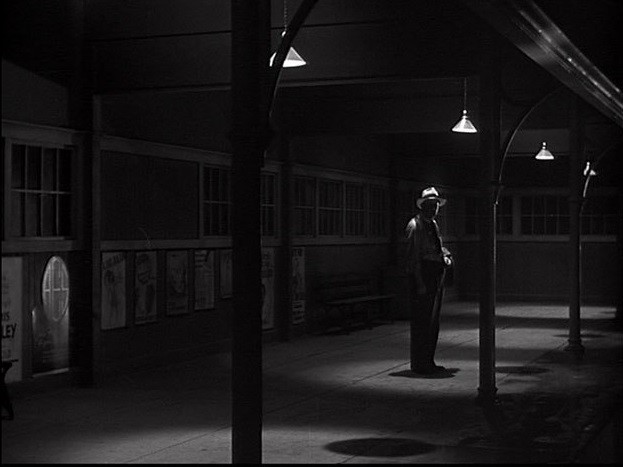
Phantom Lady
The situation of women and gender roles are again represented in a more progressive manner in Robert Siodmak’s Phantom Lady, inspired by the novel of the same name that Woolrich published in 1942 under the name William Irish. As in Black Angel, the novel (and the film that was inspired by it) follows the story of a wrongly accused man and the people who try to get him acquitted. In this case, a man named Scott Henderson leaves his home to go to a bar, where he meets a woman sporting a peculiar hat, with whom he will spend the evening. When he returns home, he is greeted by policemen and his recently strangled wife, the murder of whom he finds himself accused. His defence relies entirely on the testimony of the lady with the hat; however, the only person who could exonerate him is nowhere to be found. Convinced that Henderson would not have murdered his wife, his secretary, Carol Richmond, and his best friend Jack set out to find the lady in an effort to prove Henderson’s innocence. After having found the lady, whose name is revealed to be Ann Terry, Carol learns that Jack is the real killer and denounces him to the police.

Although the film deviates from the Woolrich novel in few instances, it nevertheless becomes clear that in both film and novel, women are in position of power and retain control over the fate of the men and over the narrative. Again, as in Black Angel, a woman takes the role of the seeker-hero as Carol Richmond races against the clock to free Henderson, whom she loves. Her actions, therefore, will seal his fate. Carol has control, in a sense, over Henderson’s life. In addition, another female character, Ann Terry possesses control in Phantom Lady. First, according to Tony Williams, she has refused to give her name to Henderson, “thus rejecting male control over her identity” (William 137). Then, once the audience realises – simultaneously as Henderson does – that the ‘phantom lady’ possesses the key to the male protagonist’s freedom, Ann Terry gains control over the narrative, and as Carol, over Henderson’s life.
Women are clearly established as holders of control and power, so much so in the case of Carol, that she becomes a literal threat to the lives of two men in particular. In both the film and the novel, Carol inadvertently causes the death of two men, who are linked to Henderson’s case: the barman, and the jazz drummer, Cliff. In her encounters with each of these men, Carol becomes a threat by usurping “a traditional male prerogative,” the gaze (Williams 138). The scene involving Elisha Cook Jr.’s Cliff is the most interesting example of Carol using the gaze as a weapon. Like Woolrich writes in his novel, Carol becomes engaged in a game of seduction with the jazz orchestra drummer, Cliff, in an attempt to get him to confess that he saw Henderson with the ‘phantom lady’. She accompanies him to a club for a jam session, during which she watches him plays in a rather suggestive manner, full of “wordless sexual innuendoes” (Nevins 140). She becomes the authoritative figure as she dominates Cliff with her eyes only, reducing him to a powerless victim.
However, the film’s narrative makes it painfully obvious that she will not be able to retain authority and control. As Tony Williams point out, in the last ten minutes of the film she goes from being a threat to being threatened (Williams 135). If in Cornell Woolrich’s novel Carol plays a significant part in trapping Jack Lombard, the film – perhaps in an effort to be more conservative – tries to re-establish more traditional gender roles to rebalance the power Carol has acquired. As Franchot Tone’s Jack Marlow is revealed to be the killer, she feels threatened, loses control and is saved from a near certain death by Inspector Burgess, an obvious patriarchal figure, representing law and order. Up until the end, Carol has been an active and dominant figure, clearly contrasting Henderson’s passivity while he waits on death row. Carol’s power must be stripped away from her in order to make it clear that she will be submitted to patriarchy as she was before, as expressed once again in Henderson’s final dictaphone message, in which he tells her that they will be together forever. In this context, it might be fair to say that although Woolrich has done significant efforts to renegotiate the structure of female representation in his art, the American film industry might not have been ready to display this kind of female empowerment on the big screen and therefore decided to once again, show that women should, first and foremost, be wives.
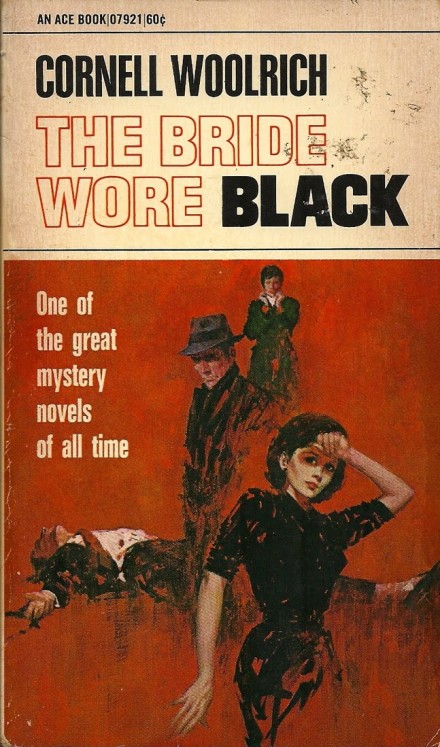
The readiness of the cinematographic industry to present subverted gender roles is an equally interesting topic to explore as it pertains to Woolrich’s first mystery novel, The Bride Wore Black. Published in 1940, this novel would however be the last of the author’s stories to be made into a film during his lifetime. Tony Williams points out that this late appearance might be justified by the fact that the film’s female protagonist “is a powerful threat to patriarchal ideology … and could not be successfully incorporated into the ‘40s norms of Hollywood gender representation” (Williams 132). It is easy to agree with Williams as the Hollywood film industry of that period did indeed stay far away from such a novel and it was French-director François Truffaut, in 1968, who took on the challenge of making a picture inspired by Woolrich subversive novel. In their own ways, Woolrich and Truffaut both tell the story of a widow who tracks down the men who are responsible for the death of her husband, killed on their wedding day. One by one, she kills them in revenge for the man she lost. Truffaut, however, moves the action from the United States to France and Switzerland and rids the narrative of the investigative structure by considerably reducing the role of the detective who played a significant role in Woolrich’s story. By doing so, Truffaut allows the audience to be in a sort of private dialogue with Jeanne Moreau’s Julie, who becomes inherently sympathetic to the audience. In a sense, by being so closely acquainted with Julie, the audience will undoubtedly want her to succeed in her quest for revenge.
As Catherine Bennett and Carol Richmond, Julie does indeed have a mission; she is seeking something in particular. Although, because the nature of her quest lacks an investigative component, she cannot be defined as a seeker-hero in the sense Michael Walker meant it. However, she seeks to kill. She becomes a huntress, and her preys are men who wronged her. This encapsulates the manner in which both Woolrich and Truffaut comment on and subvert gender roles in the story. The men who are responsible for Julie’s husband’s death are hunters. Most of them are somewhat rich and powerful men who hunt not only animals, but women as well. By dominating women, they become mightier, however, once they make contact with Julie, they become passive and dominated. Julie strips them of their power by becoming the huntress. In the words of Williams, she is a powerful heroine who “kills her victims after reducing them to helpless dependency” (Williams 132). In their last moments, two men – Coral and Morane – beg Julie for their lives, truly becoming passive and impotent victims. In the tradition of noir, Julie could be equated with a femme fatale; however, this appears almost too weak a word to define Julie. Unlike Cora Smith or Kathie Moffat, Julie already has power and does not need a man to obtain it. If the classical femme fatale of films such as Double Indemnity played out the role of the ideal women to get some of the men’s agency and power, Julie does it only to get revenge using her own dominance.
Both Truffaut and Woolrich go to great effort to make sure that the huntress metaphor does not go unnoticed by their audiences, pushing it so far as to make her pose as Diana, goddess of the Hunt for one of the men, whom she will kill with bow and arrow. The metaphor therefore becomes complete – and truly obvious – as she has literally hunted a man. The film, however, also encapsulates another metaphor, as it not only represents Julie’s revenge on the men who made her a widow, but also a revenge of gender; the oppressed female revenge on the dominant males. Perhaps due to the parallel effort of both Cornell Woolrich and François Truffaut, The Black Wore Black is the only one of the three films discussed here that resists the temptation of rebalancing the gender roles in the end. Indeed, the film carries out the comment on gender roles up until the last few seconds of the film when once again, by murdering her last prey, Julie is the dominating figure.
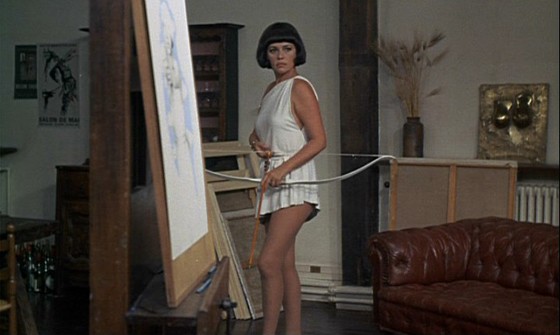
In the patriarchal and male-centric noir world populated by Dashiell Hammett, Raymond Chandler, Mickey Spillane or James M. Cain’s rather misogynistic heroes, the novels of Cornell Woolrich offer crucial comments on gender roles. Indeed, the former writers’ male protagonists were displayed as typical examples of toxic masculinity, often portrayed by the iconic actors such as Humphrey Bogart, symbolic of the active and dauntless man. In this context, the fact that Cornell Woolrich chose not only to portray indomitable female seeker-heroes in some of his mystery novels appears nothing short of revolutionary. However, Woolrich does not merely subvert the traditional gender roles associated with women by giving them position of control and power in his novels, he does so too in portraying male characters as passive victims, their fate lying solely in the hands of the female heroine. Kirk Bennett, Scott Henderson and the victims of Julie in The Bride Wore Black do indeed fit this bill, however, many other male characters in the noir world can also be identified as such. According to Tony Williams, both of Burt Lancaster’s roles with Robert Siodmak in The Killers and Criss-Cross are “echoes of Woolrich’s doomed male victims of romanticism, especially in their respective manipulation by femme fatales Ava Gardner and Yvonne de Carlo” (Williams 133). Many male heroes of the subsequent years, well after the end of the Noir period can also be linked to the Woolrich-model. In the way he commits capital offences in the hope to get the attention and seduce a woman, Taxi Driver’s Travis Bickle is certainly amongst those. As a result of Cornell Woolrich’s efforts to undermine traditional gender roles in his novels, some noir films such as such as Black Angel, Phantom Lady and The Bride Wore Black can stand as less misogynistic alternatives to classical film noir which perpetuates the notion that women have a role in the household as wives and mothers. Cornell Woolrich’s novels and the films that they have inspired are in their way eroding the traditional ways of representing women in relation to an inherently patriarchal structure.
Works cited
Kaplan, E. Ann. “Introduction.” In Women in Film Noir, edited by E. Ann Kaplan, 1-5. London: British Film Institute, 1980.
Nevins, Francis M. “Translate and Transform: from Cornell Woolrich to Film Noir.” In Film Reader 2, edited by Alan Silver and James Ursini, 137-157. New York: Limelight Editions, 2003.
Walker, Michael. “Film Noir: Introduction.” In The Book of Film Noir, edited by Ian Cameron. New York: Continuum, 1993.
Williams, Tony. “Phantom Lady, Cornell Woolrich and the Masochistic Aesthetic.” In Film Noir Reader, edited by Alan Silver and James Ursini, 129-143. New York: Limelight Editions, 2003.
Films cited
Black Angel, dir. Roy William Neill, scr. Roy Chanslor, based on Cornell Woolrich’s 1943 novel The Black Angel, United States of America, 1946, 81 min.
Phantom Lady, dir. Robert Siodmak, scr. Bernard C. Schoenfeld, based on Cornell Woolrich’s 1942 novel Phantom Lady, United States of America 1944, 87 min.
La mariée était en noir (The Bride Wore Black), dir. François Truffaut, scr. Jean-Louis Richard and François Truffaut, based on Cornell Woolrich’s 1940 novel The Bride Wore Black, France 1968, 107 min.
Murder, My Sweet, dir. Edward Dmytryk, United States of America, 1944, 95 min.,
The Killers, dir. Robert Siodmak Siodmak, scr., Anthony Veiller, based on a short story by Ernest Hemingway, United States of America,1946, 103 min.
Criss Cross, dir. Robert Siodmak, United States of America, 1949, 88 min.
Out of the Past, dir. Jacques Tourneur, United States of America, 1947, 97 min.

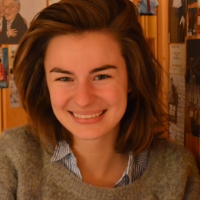

-small_400_258_90_s_c1.jpg)
